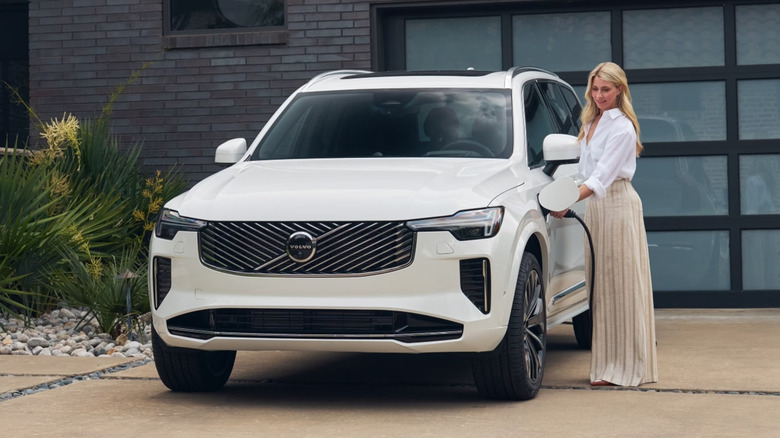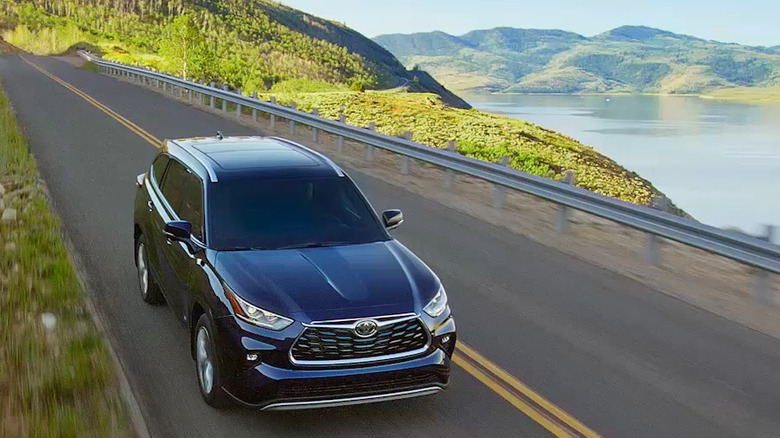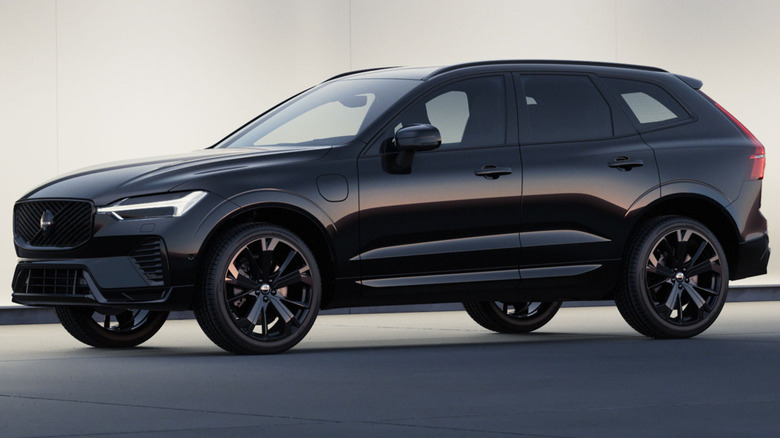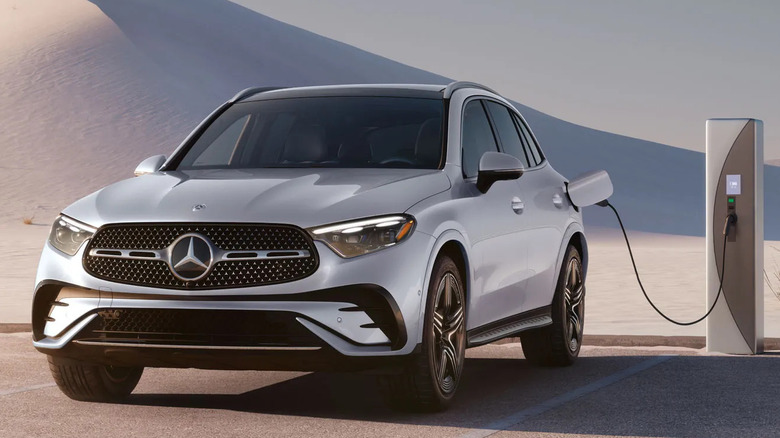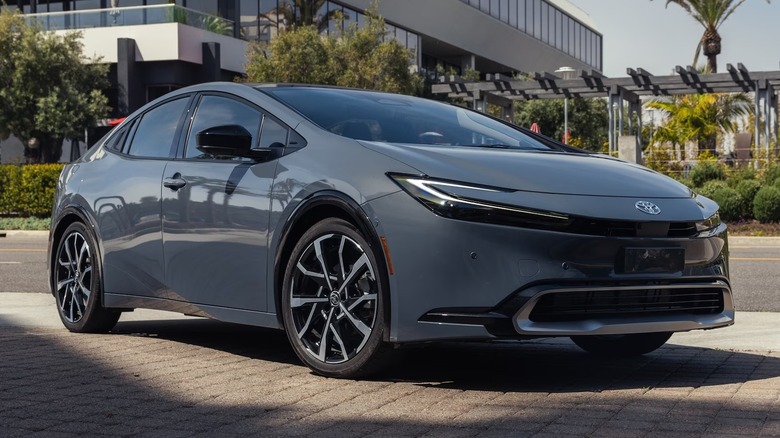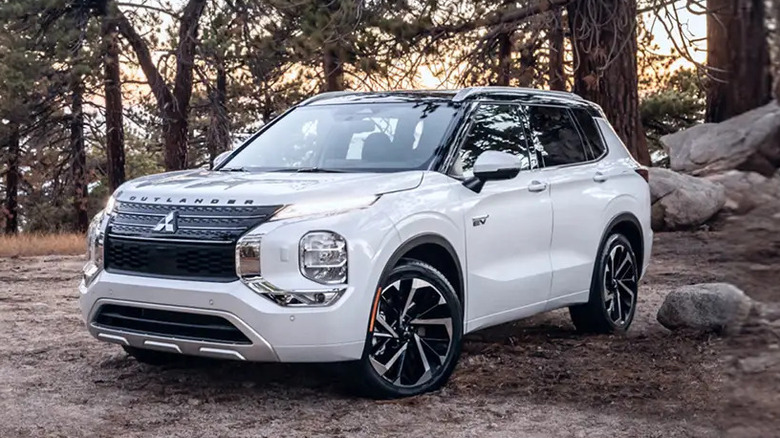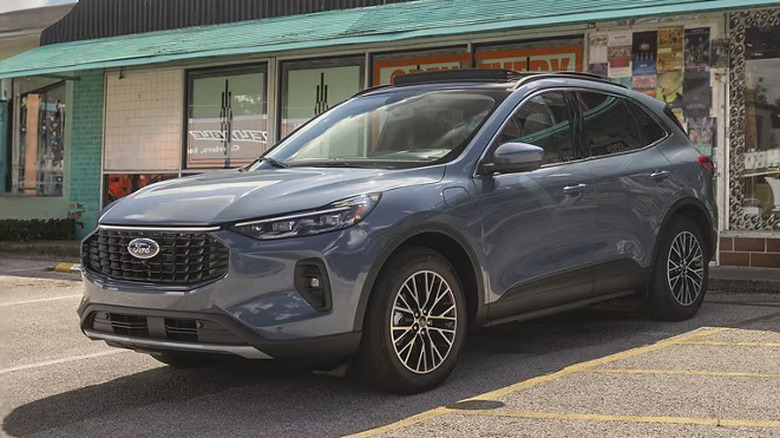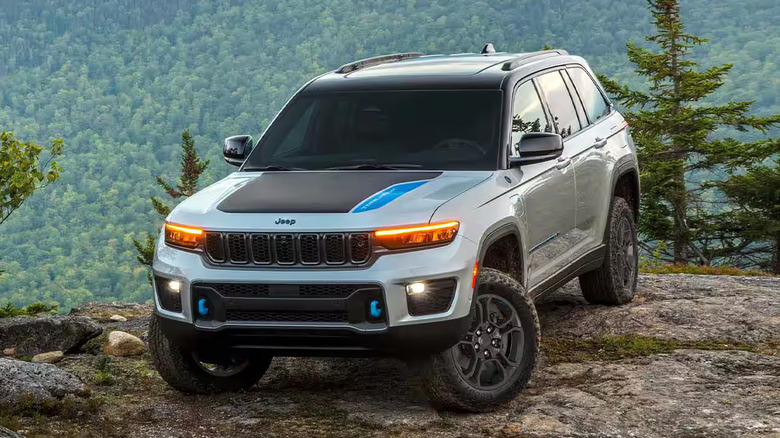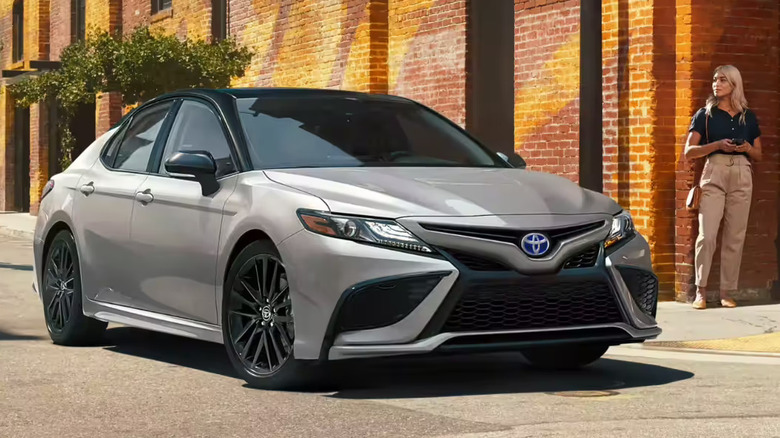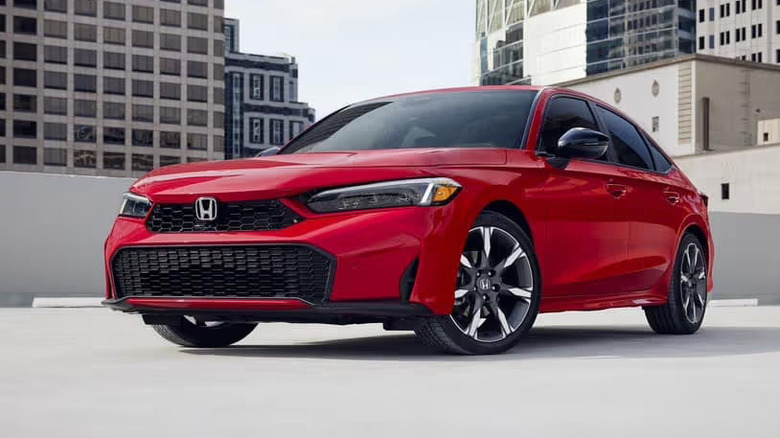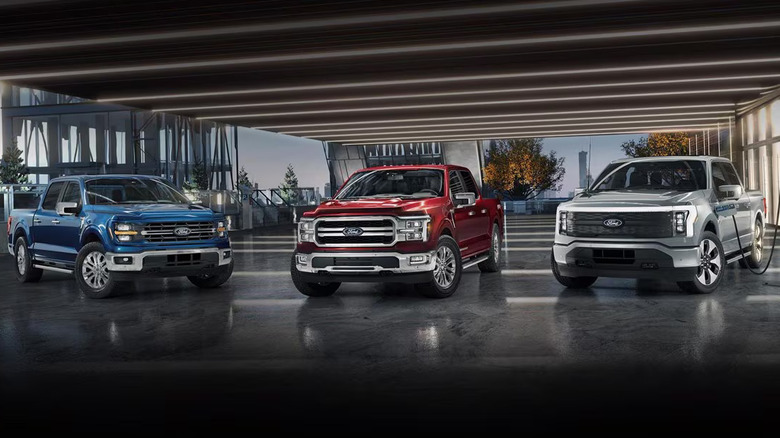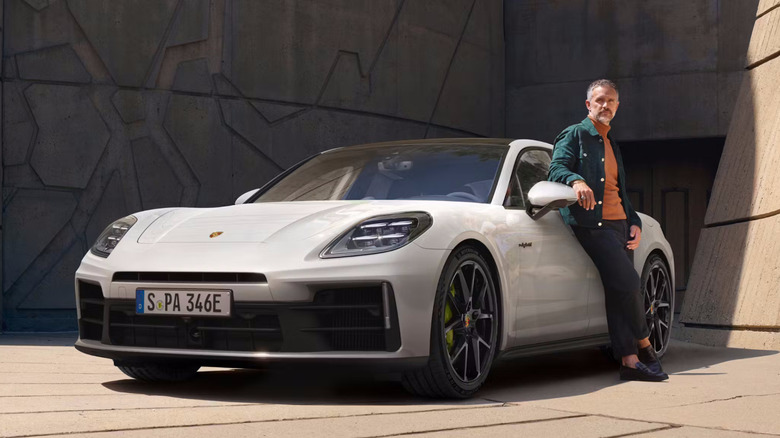13 Things To Consider Before Buying A Hybrid Vehicle
My first serious research into electric cars started in the early 2000s, when I had an environmental science teacher who proudly drove a Prius. He loved debating about the pros and cons of electric versus gas, from the costs to the ethics to whether the cars on the market looked cool. At the time, it was rare where I lived to spot a hybrid in the wild, but I never forgot those first conversations about battery recycling, MPG, and how ugly some people considered Priuses to be.
These days, buying a hybrid vehicle is even more complicated, especially because the market is saturated. With tons of decisions to make before you ever sign on the dotted line at a dealership, hybrid shopping can be intimidating. That said, there are plenty of benefits to choosing to buy a hybrid versus a gas-powered car or an all-electric model.
Here, though, we won't be listing out pros and cons. Instead, we'll cover all the angles to consider as you dive into the hybrid market, which happens to include various hybrid configurations and a long list of features to keep an eye out for.
Motivation
The very first thing to consider is what your motivation is for wanting a hybrid vehicle. This will dictate what brands or models you seek out, what features to prioritize, and how much you're willing to spend. Maybe you're trading in a gas guzzler for a hybrid because the costs are too high, in which case you'll want to do some math to determine whether the potential gas savings justify the sticker price.
On the other hand, maybe you're hoping to do your part in saving the planet. In that case, the up-front cost might be less of a concern, but maybe you're taking a closer look at eco-friendliness in multiple metrics. For example, you might want to research how long a hybrid vehicle's battery lasts or where your brand-new car will be shipped from. Some hybrids are assembled in the U.S., like the 2025 Honda Accord and 2025 Toyota Camry, but that doesn't mean all their parts are — but more on that later.
Other motivating factors could span must-haves like comfort, looks, reliability, advanced technology, and more, but not every hybrid on the market will deliver. Thus, it's important to categorize your motivations before looking at what's on the market.
Environmental impact
Whether you're prioritizing its sustainable impact or other features, the environment is part of the reason hybrid vehicles exist in the first place. Saving the planet will take more than everyone driving a hybrid car, but it's a step that could help reduce society's reliance on fossil fuels. At the same time, manufacturing any new vehicle undoubtedly impacts the environment, as does driving an older vehicle that produces more pollution. While we can't say that you should or shouldn't buy a hybrid vehicle for environmental impact, considering your personal stance on the matter will help you figure out what hybrid to buy and from where.
For example, Volvo has plans for a U.S.-made hybrid, which could involve some financial as well as environmental benefits. U.S.-made vehicles could cut down on transportation costs, among other factors, when it comes to consumer perks. On the other hand, hybrid batteries can and do die, with hybrid battery lifespans estimated at around 10 years. The lifespan of your hybrid car's battery will depend on many factors, including how often you drive. Battery usage (and the potential for recycling) is just one part of the environmental equation, so if this is important to you, do your research.
True hybrid (or not)
If you picture a Prius when imagining a hybrid vehicle, you're not alone. Fortunately for consumers, there are tons of hybrid options on the market today, yet not all are true hybrids. Today's consumers can opt for a hybrid vehicle like a Toyota Prius C or Honda Accord Hybrid, or they can dive into the world of energy-efficient acronyms with a PHEV or MHEV.
A hybrid electric vehicle uses multiple power sources to move. A hybrid such as the Toyota Prius C uses a gasoline engine and an electric motor. You can't plug in this type of hybrid. Instead, the electric motor pulls energy from an onboard battery, which is charged by the gasoline engine and by regenerative braking. The two systems work together to give you better MPG than a gasoline-only version.
Plug-in Hybrid Electric Vehicles (PHEVs), on the other hand, use a similar system as a hybrid electric, but can also be plugged in to charge. Newer model PHEVs include the Prius Prime, Hyundai Tucson Plug-In, Ford Escape PHEV, Jeep Wrangler 4xe, and more. Other hybrid variations include Range-Extended Electric Vehicles (REEVs), which primarily use an electric motor (and plug in to electricity) but use gas engines or generators as backup. Mild Hybrid Electric Vehicles (MHEVs) use electric motors for a boost, but can't run only on electricity. Knowing these definitions can help you make the best buying decision for you.
Driving experience
Driving a hybrid for the first time might surprise you. In many ways, a hybrid vehicle can feel a lot like a standard gas vehicle. In terms of handling and overall power, I didn't notice a difference between the other Toyotas I've owned and my Prius. However, the first time I drove a hybrid, the lack of engine noise made me think the vehicle wasn't on — and I've been known to forget to hit the power button to shut the car off when parking.
The lack of engine noise isn't the only unsettling detail about driving a hybrid for the first time. You might need a few test drives to familiarize yourself with the noises a hybrid car makes, from no noise at all to a light humming sound while running on electric only to a whirring at seemingly random times. Some hybrids (like the Prius) also have a selection of buttons to choose from: power or eco-friendly mode. Research the car you're considering to figure out how to use those features during your test drive. For example, while you might use engine braking in some situations in a gasoline-powered car, in a hybrid, regenerative braking is the default, and the car is essentially programmed to recycle that energy.
Cost-benefit comparison
Finances are a big factor in buying a hybrid, but a true cost-benefit comparison involves more than sticker prices. Depending on the vehicle, its mileage and energy needs, and a myriad of other factors, the numbers could skew either way. In general, however, Consumer Reports suggests that over five years of ownership, a plug-in hybrid has the potential to save you more money than a hybrid (when both are compared to the expense of a gas-powered car). Plus, hybrid SUVs with the best fuel economy outcompete their gas-powered counterparts by as much as 15 combined MPG.
Don't forget to include add-ons in your cost-benefit cross-check. For example, the Prius Prime has a roof solar package option, but it's only available on the Prime XSE Premium — the most expensive Prime in Toyota's 2026 model year lineup. The solar roof option is $610 and offers 185W of power, which MotorTrend determined could add about four "free" miles to your range each day. However, it could take weeks to fully charge the whole car, and it could take five years for the solar panel to pay for itself.
Maintenance is also a consideration, from regular upkeep to charging. For those hybrids that can also operate as electric-only, ownership can be more expensive, especially with a home charging setup. While the most reliable plug-in hybrid cars could minimize your long-term expenses, thinking about these costs will help give you a clearer picture of the financial impact of hybrid ownership.
Charging infrastructure
A significant factor for consumers considering electric vehicles is the availability — or lack thereof — of charging infrastructure. Despite how low electricity costs might be compared to gasoline prices in terms of cost per mile, the numbers are different for everyone. A hybrid car can feel like a safer alternative when charging stations are few and far between.
Local gas prices, energy costs per kilowatt hour, and infrastructure could also make electricity more expensive than gas, or vice versa, which is why a hybrid could be an excellent solution. After all, even the hybrid vehicles with the longest electric-only range can only travel 30-something miles before needing a charge (or a gas assist).
Thus, some drivers may lean toward a hybrid solely to avoid relying on the availability of charging stations. Many PHEVs, like the Prius Prime, can run on gas or electricity, making it easier to get energy wherever you go. Yet, if you have no charging infrastructure where you live, you won't get the maximum energy benefit with that model, and might end up paying more than you would for a true hybrid.
Service support
You might expect that a hybrid car, since it has a gasoline engine, could be serviced just about anywhere. If you live in a bigger city, that might be true. However, I live in a small county where some shops don't know what to do with a hybrid, let alone a newer one like a Prius Prime. In fact, a lot of people in my area seem unable to identify a hybrid car, unless it sneaks up on them in electric-only mode.
Even in urban areas, consider how far you'll need to travel — or how long you'll have to wait — to receive service for your hybrid. You might find a local shop that's fine with handling most maintenance, like oil changes, or you might need to return to a branded dealership for service.
Especially if you plan to order a brand-new vehicle, figuring out service access is crucial. True, most new vehicles eventually wind up with recalls and service bulletins. However, because hybrid cars have dual engine systems and a lot of onboard technology, you may expect them to need more nuanced service support than the average vehicle, and especially more than a used one.
Fueling time
One of the reasons I love my Toyota Prius hybrid is that I can travel over 400 miles on a single tank (10 gallons) of gas. Refueling takes the same amount of time (or slightly less) than with a gas vehicle, a matter of minutes. In contrast, charging an EV is nowhere near that fast, and likely won't be, at least not for a long time (and with the help of various technological advances). Again, a hybrid might be the best of both worlds, but a plug-in hybrid (like a PHEV or REEV) gives you more options.
Whether those options are worth the price tag and the cost of charging at home or on the go is up to the individual, which gives you even more to contemplate before driving off the car lot. As advanced as electric cars can be, my friends with a Tesla have been known to sit in parking lots for an hour or more to get their car charged up enough to make it home. With a plug-in hybrid, you have the option to switch to gas, but the convenience might mean that you don't reap the full benefits of the plug-in feature.
Emissions
In terms of making an effort to reduce your carbon footprint, hybrid emissions are an important part of the conversation. In most cases, it's an apples-to-apples comparison to look at the emissions of a hybrid versus a gasoline car of the same make and model. For example, consider a 2024 Honda Accord versus the Hybrid model. The U.S. Department of Energy estimates that the gasoline-powered Accord produces 4.6 tons of greenhouse gas emissions per year — over 1.5 times the amount that the hybrid is estimated to produce.
The gasoline-powered Accord also produces slightly more tailpipe CO2 than the hybrid, but when you look at the EPA ratings of both models, things get confusing. In California, both vehicles have the same EPA Smog Rating, a 7 out of 10 (10 being the best score). For most emissions, the hybrids win out. For this reason, it might be worth doing a direct comparison of emissions between models you're considering, while also factoring in costs and other aspects of purchase and upkeep.
Available features
Newer vehicles come with all kinds of technology that we could never have imagined while driving around in the 1900s. Things like Bluetooth-compatible stereos, touchscreen panels, and backup cameras may be the norm these days, so it may not matter whether you choose a hybrid, some hybrid variant, or a gas-powered car.
Yet, if you're looking for a few select features, you might not find them in a hybrid. For example, there are new hybrids with AWD available, but it's a shorter list than, say, the list of all available hybrids. If four-wheel drive is on your wish list, the possibilities narrow down even more. That said, big-name brands are coming out with new hybrid vehicles all the time, so options expand each year.
For now, if you're after four-wheel drive, there are a few strong brands already dominating the pickup truck market. For example, Toyota offers both Tacoma and Tundra hybrids; the i-FORCE MAX gets an estimated 20/24 MPG, but it could be worth exploring. Similarly, Ford's classic F-150 now comes in a hybrid iteration, and the F-150 Lightning has an electric-boosted range of 320 miles.
Onboard options
We suggest testing multiple hybrids to get a feel for how regenerative braking works and to test out the different features. For example, there are EV and Eco modes on Toyota hybrids, and activating either one can change how the vehicle drives. Eco mode, which aims to optimize fuel efficiency, means that stomping on the gas pedal won't get an immediate response; slow acceleration helps the car sip on, rather than guzzle, gasoline.
You might also find that certain hybrid features are more of a pain than they are useful. For example, my dad's Prius Prime phone charger is hit or miss. Even though the charging slot is designed for wireless charging, it doesn't always work. Plus, some preset features, while ultimately useful, are frustrating during daily use. The 2024 Prius Prime was our family's first introduction to Toyota Safety Sense, a feature common in new (and not just hybrid) Toyotas.
The feature takes certain actions in different scenarios to, theoretically, keep the vehicle's occupants safe, like decelerating when the vehicle ahead slows down. Of course, it's not always fun to have the car slam on the brakes when the vehicle ahead is simultaneously slowing down and exiting the roadway. If it's been a while since you've bought a new car, check out what features might feel intimidating in a new-to-you hybrid, and prepare to read the user manual thoroughly.
Availability
Depending on where you live and where the hybrid vehicle you want is manufactured, you might encounter issues with availability. Some vehicles have to be special-ordered, and you can expect new models to sell out right away. If you want a specific color or feature package, the wait could be longer with a brand-new car. Even used hybrids can be hard to find if the models have been discontinued or are otherwise in high demand.
Also, as noted, there are not many hybrid pickups to choose from, but there are some highlights. The F-150 Hybrid's MPG is said to be better than the gas version, and the Ford Maverick Hybrid starts at around $29,000 MSRP. Sadly, a revived classic, the Ford Ranger PHEV, is not available in the U.S., but more options may arrive on the market in the coming years.
All that being said, if environmental and financial concerns are your top considerations, buying a used hybrid with reasonable gas mileage at an affordable price could be the best combination of options.
Aesthetics
When I recently told a college class that I drive an older Prius hybrid, a lot of them laughed. Clearly, Priuses are still not cool. If one of your priorities in purchasing a hybrid car is to maintain a certain aesthetic appeal, that will narrow your options significantly, according to some college students. Though looks aren't everything, many of the flashier hybrid models are also faster and have more features than their humdrum counterparts.
Some fast hybrid daily drivers look a bit cooler than the earlier generation, but you can expect to pay a pretty penny for a hybrid Porsche compared to a Toyota. Other brands, like Lexus and Mercedes, also have hybrid models that don't look too different from their standard gasoline-powered lineup.
There's nothing wrong with wanting a car that both looks good and feels good, in terms of what it can do for your bottom line as well as the environment. Before you head into a dealership to ask to test drive all the hybrids, take a spin around the lot and nix any that don't match your aesthetic values — or you might wind up driving a Toyota Prius hybrid, too.
